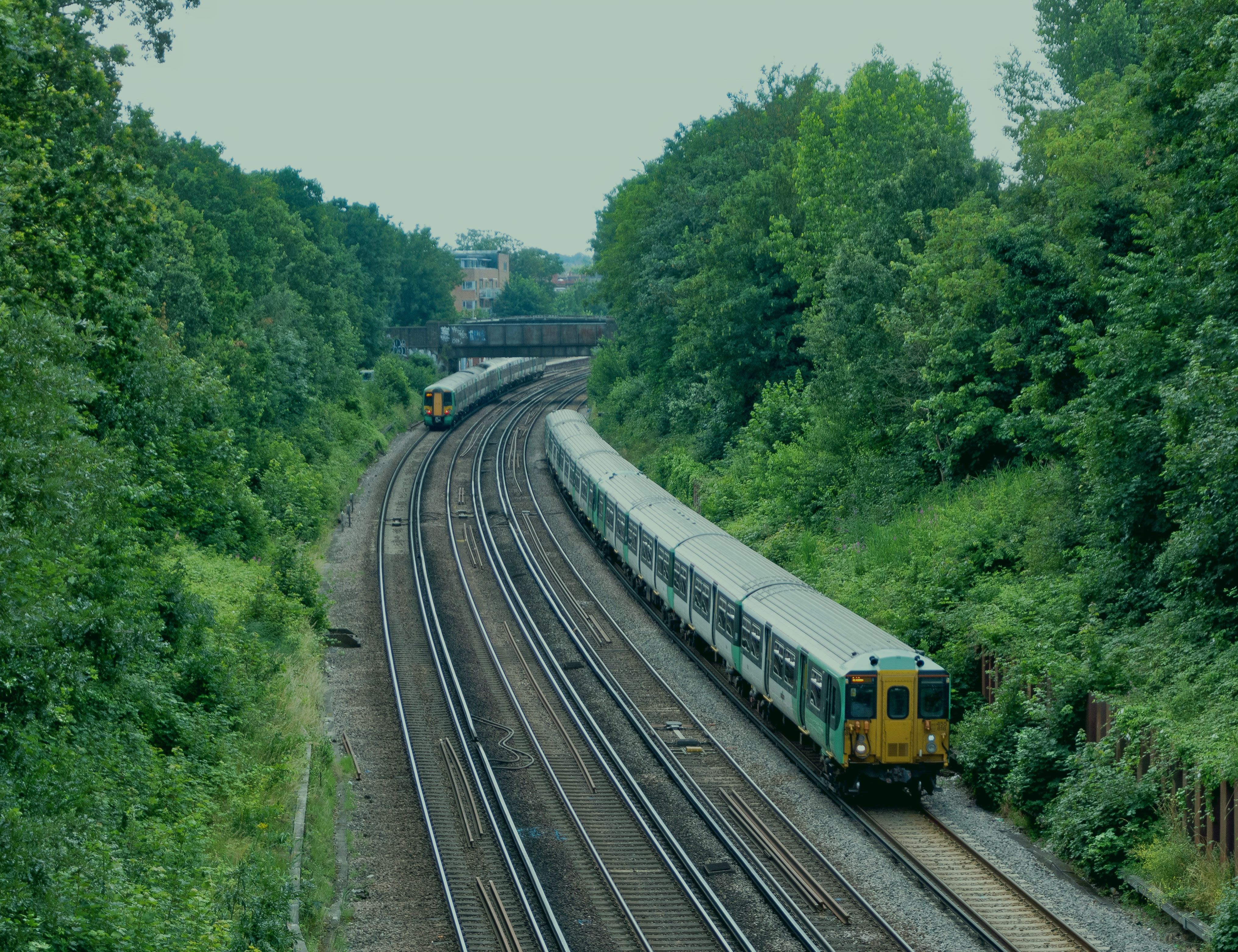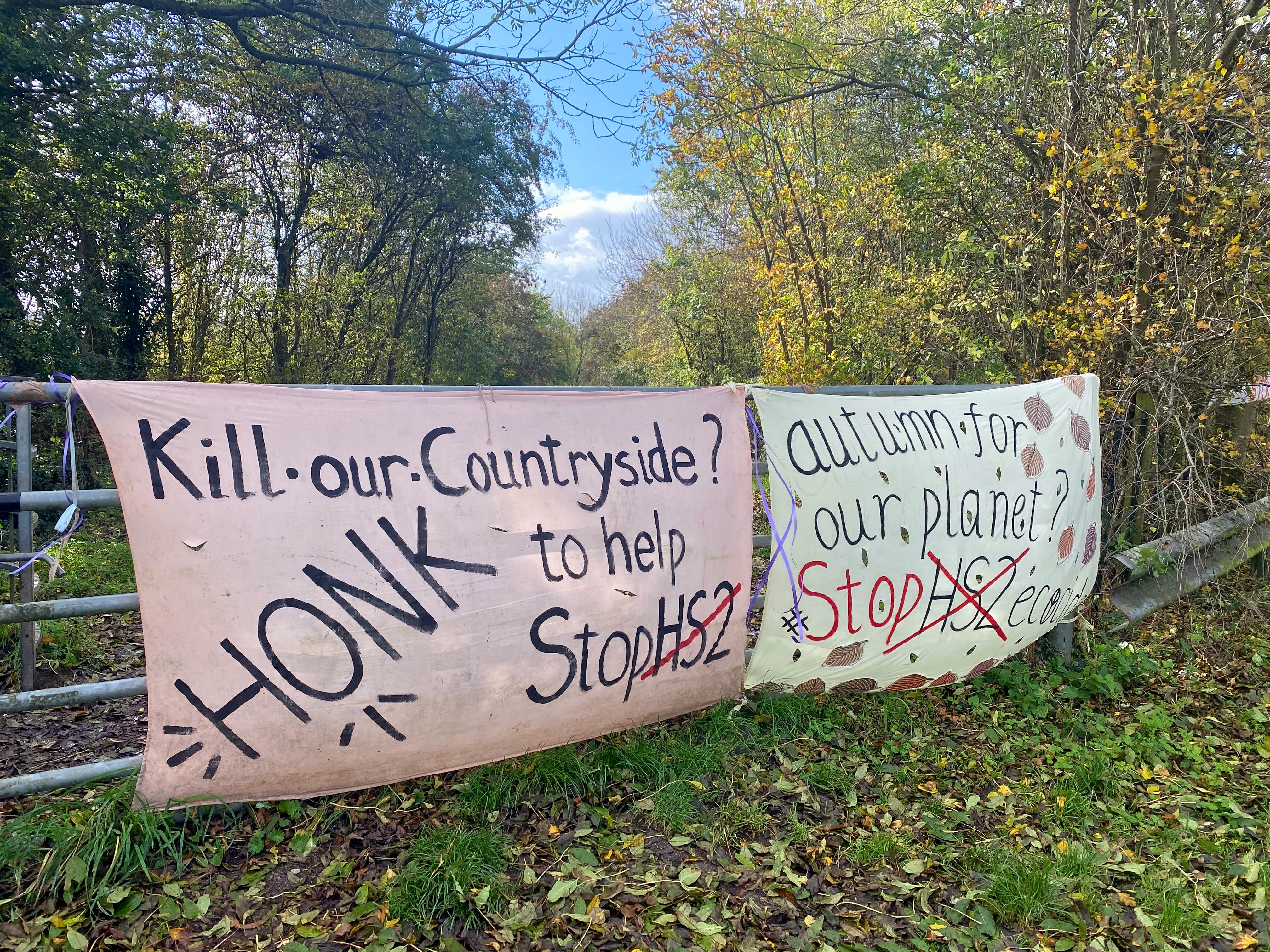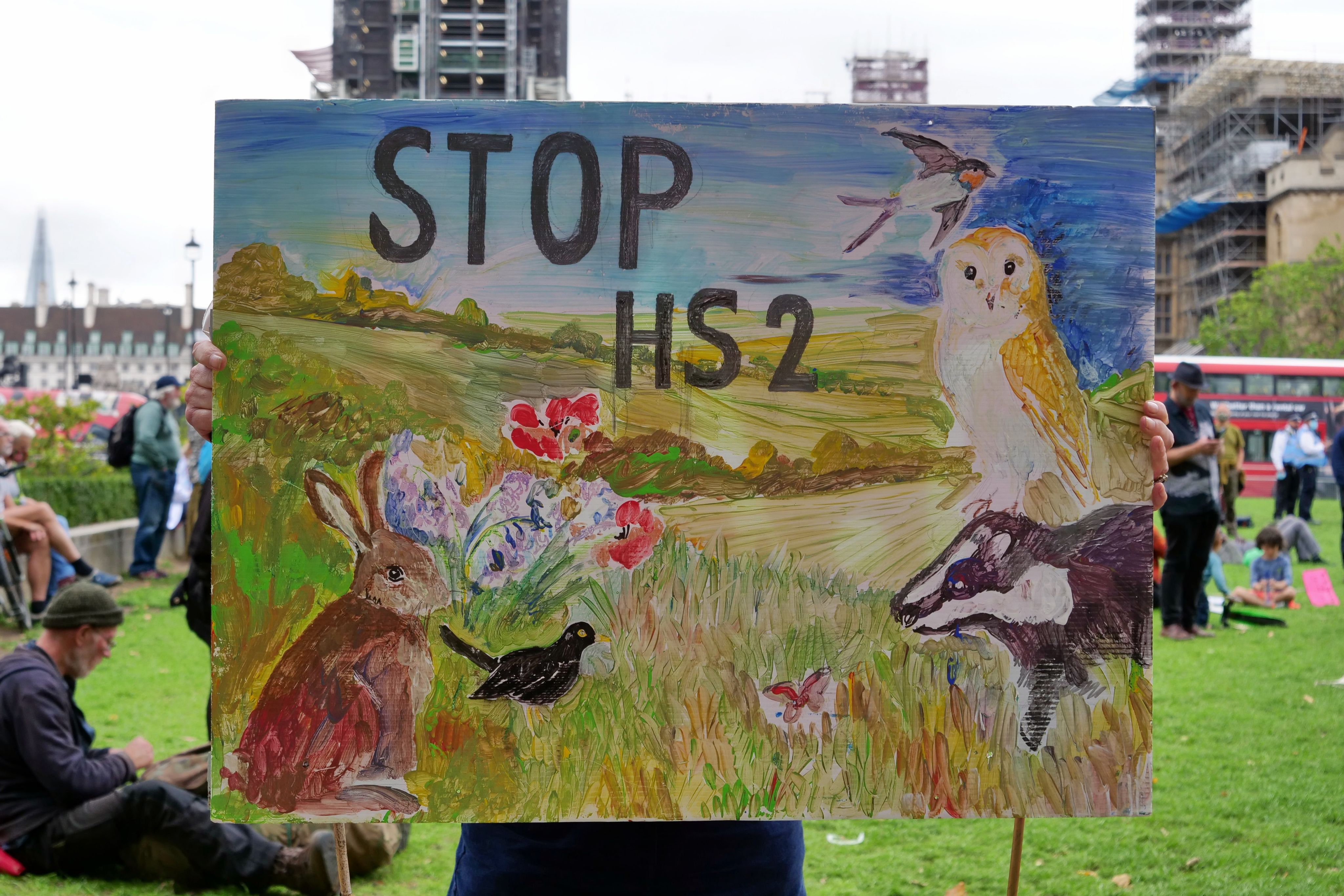Podcast: What next for HS2?
Following the UK government's decision to abandon the High Speed Two rail project, join our experts to understand what went wrong - and what happens next

In this podcast, we'll be talking about the future of the UK's High Speed Two rail project following the government's decision to abandon the original plans for the project.
Experts from The Bartlett examine what went wrong with High Speed Two – including why costs were underestimated, and key project management issues – and look to the future at what is needed in the leadership of major infrastructure projects like this.
Listen to the podcast
The Bartlett Review Podcast: What's next for HS2?
Image credit: Dylan Hayward on Unsplash
Image credit: Dylan Hayward on Unsplash
Image credit: Ethan Wilkinson on Unsplash
Image credit: Ethan Wilkinson on Unsplash
Transcript
Priti Parikh: This is a podcast from The Bartlett Review, sharing new ideas and disruptive thinking for the built environment. Brought to you by The Bartlett Faculty of the Built Environment at University College London.
Tim Broyd: When you introduce fundamentally different types of transport, it’s very difficult to establish what the benefits will be, even though it’s all too easy to count the cost.
Priti Parikh: In my view it’s important that we discuss the value and leadership around complex infrastructure projects to avoid what has happened to High Speed Two.
John Kelsey: When you build an infrastructure project it’s unique and the prototype is also the final product – there’s no chance to test a first model.
Priti Parikh: Hello, I'm Priti Parikh, professor of infrastructure engineering and international development and director of the Bartlett School of Sustainable Construction.
In this podcast, we'll be talking about the future of the High Speed Two rail project for the UK. Following the government's recent decision to abandon the original plans for the project. The line between Birmingham and Manchester has been scrapped and we don't know whether the tracks between Old Oak Common and Euston Station in Central London will be completed.
With me to discuss this are two of my colleagues from the Bartlett School of Sustainable Construction, John Kelsey and Tim Broyd. Professor John Kelsey is an expert on major projects and also delivers curriculum for our Major Infrastructure Delivery MBA programme. Tim is a professor of built environment foresight with long experience of industry. His work focuses on issues of digital transformation of the construction and infrastructure, and he is a past president of the Institution of Civil Engineers. Welcome to both of you.
Tim Broyd: It's good to be here.
John Kelsey: It's very nice to be here.
Priti Parikh: Wonderful to have you both. I want to dig straight into costs because I know that this is a question on everyone's mind. So John, why was the initial budget so inaccurate? Decisions have been made on the basis of costs, but what are the wider benefits?
John Kelsey: From my own experience on the channel tunnel, I encountered many complexities and technicalities that could not reasonably have been foreseen. Research shows that costs in projects of this type almost always are underestimated. The direct benefits overestimated, but the wider economic benefits underestimated, which maybe is something that we should focus on, namely the value, the long-term value of the project and not just the cost.
Priti Parikh: So Tim, from the project management perspective, how did we get here? Why wasn't inflation and the high cost of the technology taken into account?
Tim Broyd: They hardly ever are. I mean, we start project long projects during the project lifetime. It is quite normal for technologies to be developed or for codes and standards to be upgraded or brought in from new. So for example, in construction of the Elizabeth Line, formally Crossrail, the whole of the BIM, that's the building information modeling explosion happened. New standards were brought in which the project had to accommodate, but also when the project was conceived and budgeted, smart phones hadn't been developed, let alone tablets, let alone the internet of things, et cetera. So long projects have to accommodate all of these things in ways that are unknown when projects were initially budgeted. And in addition to what John was saying about costs, we have a very democratic planning process in the UK. Now, what that led to in the section of High Speed Two between London and Birmingham was a more than doubling of the length of line going through tunnels. Now, obviously tunnels are very much more expensive than putting a line across the land, but this was seen as a necessary step to allay public concern of visibility and retention of, should we say, a tranquil countryside.
John Kelsey: Tunneling is not only very much more expensive, it's very much less predictable because the state of the geology and underground is not known until you actually dig it up even with a number of trial boreholes.
Priti Parikh: And that's an interesting point because with large projects there's an expectation that we predict cost and wider benefits from the outset. But I wanted us to consider the wider implications and benefits for UK. So why was High Speed Two conceived? I would say the benefits would be categorized into three Cs. One is capacity building, so improving the capacity of freight and services. The second C for me would be carbon, carbon reductions, because if we want to achieve carbon reductions, we need safe, affordable, and reliable transportation. And the third C for me, which I think is most important, is connectivity. Good public transportation helps to connect communities to healthcare, to education facilities. So the benefits of good transportation projects are wide ranging.
John Kelsey: Can I comment on the carbon? I agree with you on the connectivity and the capacity. This is not a particularly green project in terms of carbon because although there will certainly be some savings in terms of shifting traffic from road to rail, there is a huge embodied carbon in the materials that will be used in the energy used in actually constructing HS2 in the first place.
Tim Broyd: But you have to remember also that railways last, they last a long time. The vast majority of England's strategic rail network was built between 1830 and 1860. We are still using the lines in some cases, many of the stations that were built in those times and they've lasted so far approaching 200 years. So yes, I accept that the embodied carbon is high, the reduction in operational carbon, If we can make a switch from road to rail – and particularly in freight, and let's remember that whilst we call it High Speed Two, its main purpose is really to increase capacity on the rail network, but to do things a bit faster than just to go hell for leather, for speed. So if we can make that change, then it can make a huge difference to the carbon emitted from vehicles. Okay. We're committed to electric vehicles within a few years time, but we'll have a legacy of petrocarbon fueled vehicles for some decades to come.
John Kelsey: That also of course depends overall on the decarbonisation of our electricity supplier.
Priti Parikh: Of course. Another interesting point, Tim, you made is about transportation, the value addition. I traveled into work using the tube and if you look at the value addition of the tube in terms of enabling around 3 million users every day to connect to places of employment, education, healthcare – I mean, how would you quantify that value addition?
Tim Broyd: It's very difficult. Traditionally, we have relied on business models that have looked backwards to look forwards. When you introduce fundamentally different types of transport, different types of links, it's very difficult to establish what the benefits will be, even though it's all too easy to count the cost.
Priti Parikh: So if you were to look into the future, Tim, what happens now? Is there a realistic prospect of High Speed Two and other big ticket infrastructure projects ever being built in the UK?
Tim Broyd: Well, never say never. The opportunity seems to have gone for the moment, but if we look at say, the channel tunnel, that as an idea seemed to have come up once a generation since Napoleonic times. If we look at a potential barrier tidal barrage across the River Severn, that's come up every generation for about the last 150 years initially as a rail link. So never say never, but I think undoubtedly the UK standing in the world for major infrastructure projects has taken a bit of a dip, right? There is an increasing world population. We know that there is an increasing trend for people to move from rural areas into urban areas. We know that, and that will carry on largely unabated according to all forecasts. The more that people gather together in cities, the more infrastructure we need. And that includes underground infrastructure. Now with tunneling, and there's an increase in global demand. It is a global business, and we can't forget that. We can't ignore either the fact that there are only two or three manufacturer facilities for tunnel boring machines, an absolutely key part. So the whole supply chain issues in here affected by geopolitics, affected by global economies.
Priti Parikh: John, could we have done something differently and if so, what?
John Kelsey: Yeah, if I can just say something about the future. Any new line now has to withstand not the climate of the mid 19th century, but the climate of the late 21st and 22nd centuries, which are likely to suffer far more extremes of particular types of bad weather. At the moment, if there's a single snowflake, the system grinds to a halt because it doesn't happen often enough to make it worth snow proofing the line. But we've got to consider things like that when building new infrastructure.
Tim Broyd: To pick up on one of the points you made there, John, about future climate. Now traditionally a lot of civil infrastructure, and I'm thinking of bridges, of embankments, of water, retaining structures such as dams are designed to withstand a return period of maybe a one in 100, one in 150 years. With climate change, the future is a lot more uncertain, working with the old way, if you like. With our former climate, we were already in the realms of extreme value statistics, which aren't guesses but are sort of rather large extrapolations. If you change the background set of data, you're in an entirely new world.
John Kelsey: Returning to what could have been done differently. There seems to have been a procurement method which placed all the risk on the contractor, and one has to say that that's not necessarily the best way or the cheapest way of running a project, particularly where there are significant uncertainties.
Tim Broyd: It's easy to question things after the event, isn't it? But I would really question why High Speed Two was at such a higher speed than many other high-speed rail systems around the world because that does provide increased geotechnical issues that need to be designed out.
John Kelsey: Yes, and it also consumes a lot more energy. The rate of increase of energy is exponential. The higher speed you go, it's not a case of expending twice the energy for twice the speed. It's something like eight times the energy for an increased speed. There seems to have been some problem also with the management of the project, and that obviously should be investigated, but that itself does not necessarily detract from the overall value.
Priti Parikh: I want to come back to the point of the climate crisis that we are facing because on one hand we need to design infrastructure for an uncertain future, and on the other hand, we've just put a stop to a potential project which could have led to reduction in carbon if you look at the whole life design principles, so I wanted your views on this, John.
John Kelsey: There seems to be a reluctance with this particular government to follow through on all the items of the green agenda, and you could say, this is the latest one. We have to consider that this is going to last or it would last from, as Tim said, with the existing infrastructure of 150 years at least we would hope, and we've got to look to the future and what things are going to look like in the future and not look backwards, which this seems to be doing. There is post-COVID, I should say, the rail passenger numbers have actually held up. Now they've recovered almost completely post covid. We do have a post-COVID government spending crisis, but the government hasn't said, we're not going to spend this money. They've said we're going to spend it on something else. So they obviously have the money. It's a question then of prioritising different types of projects
Tim Broyd: And as a result of that, or maybe in addition to that, any delays on large projects cost money. You can't turn something off and then five years later turn it back on again, putting something in mothballs is not freezing it. There is work that has to go on. The longer it gets, the more potential there is geopolitical interference. You mentioned COVID. I would also cite the war in Ukraine as leading to a disruption in global economics. We've seen the inflation in the UK over the last couple of years. These things are really difficult to estimate in at the beginning, and sometimes you really do have to take the knock.
Priti Parikh: So John, you mentioned the green agenda and how the government has failed to meet its commitment to that. But what does this mean for the leveling up agenda, especially for those who live in cities like Manchester?
John Kelsey: Leveling up implies that we narrow regional disparities. We have greater regional disparities in the UK than most other similar countries, so clearly some serious action is required. But the real problem is not just doing the public sector investment, it's attracting private sector investment. Private sector likes to see a consistent and continuous set of policies by the public sector in order to be confident that they can then put private sector investment into a particular area. This is particularly true of regeneration projects in cities, but also applies to a wider set of industrial investment. So if the government is saying, we are not prepared to put this investment in the north, the private sector might well say, well, if the government isn't prepared to do this, why should we?
Priti Parikh: And there is a missed opportunity here. As with the train stations, there would've been potential to generate development and retail for users, and that could have been a wonderful public-private sector partnership.
Tim Broyd: If you look at Hong Kong, the largest property owner in Hong Kong is the Mass Transit Railway. We haven't taken these opportunities, I think in the past. Maybe that's because of the time the railways were built and able to hark back to a golden age that never was. But if you look back 150 to 200 years ago, then the prize was getting to London. Quite often the lines would be built by companies whose directors or shareholders were the landowners along the route. If you look at London, the reason why we have most of the London terminal stations where they are now is because that's where London stopped when the railways were built, and there was never then the perceived need when the railways were laid down to go east west. It was mainly north south. And we are living with that legacy today, even though we're in a very different social environment.
John Kelsey: There's one thing that people forget with construction and infrastructure projects. If you look at any consumer product that you have, it's been developed, tried, tested many times over. When you build an infrastructure project, it's unique and the prototype is also the final product. There's no chance to test a first model. Inevitably, it's going to be rather more expensive than perhaps it could have been if we'd built several of these and then used one as the model.
Priti Parikh: Complexity is always an interesting challenge. I work on infrastructure projects in complex and challenging settings with high density, with high level of complexity around land ownership. And actually my personal belief is that's where our skills are most needed and required. And there is a real dark art to complexity and management and leadership of complex projects and mega projects. And my sense is that those skills might be lacking in UK at the moment. And to that end, at the Bartlett School of Sustainable Construction, we have launched a new MBA programme on major infrastructure delivery, which is one of its kind. So what type of leadership do we need now to deliver mega projects and complex infrastructure projects, Tim?
Tim Broyd: I've been involved with so-called construction improvement programs, many of them government led, for about the last 30 years. And one issue that crops up time and time again and is agreed by industry is that there is a basic lack of leadership throughout the industry. Now, one of the reasons for that is, John has said, that all big projects are one-offs. There's hardly any training ground for people who aspire to run them other than “sitting with Nelly”, as the expression used to be, to learn by doing a bit of a job. With the MBA, we're taking a new route entirely. We are looking to not so much train people, but educate people into what it takes to run a seriously big program. Now, this is a two year program. It's taught in modules of nine days, to allow people who are in senior positions in their organisations to minimise the time away from the workplace.
We have had a large number of very senior people in the industry, both on the supply side, the demand side, the regulatory side, et cetera, who have been very generous with their time and effort in helping us develop the MBA. Nearly all of them are committed to teach on it as well. And the idea here is that we can educate people not only into what looks good, but what has looked bad, so that as the expression goes, we can turn bad experience into good judgment.
One of the disciplines that we haven't traditionally brought to bear on large infrastructure projects in civil infrastructure is that of systems integration compared with, say, the aerospace industry. What that means is that we tend to have projects which have sequential operations rather than totally integrated operations. So going back to the Elizabeth Line, good as it is, we had a sequence of tunnelling and earth moving, followed by a sequence of putting rails, et cetera, and followed by a sequence of putting signalling in and electrification.
The government through the infrastructure and projects authority issued a set of guidance notes in 2016 on how to start big projects, and they started with about seven modules. I won't go through them all, but there was one on governance, one on procurement, one on risk management, one on asset management, et cetera. These were refreshed in 2021, and it was only then they added a new one on systems integration. Now it's easy to be wise after the event. Personally, I think it would've been really good if they could have started with that module to give people an overall and comprehensive framework for thinking.
John Kelsey: Leadership within the construction, engineering industries tend to be dubious, if I can put it like that, a mixed experience, very possibly because contractors in particular have had to think very short term, they want to survive by the next project or the next set of projects. Research does show that a lot of major issues in construction and engineering such as safety and quality depend very heavily on very good leadership for improvement. And it is an area where we need to concentrate very much.
Tim Broyd: Beyond that, we are told by industry leaders that yes, leadership can be taught, I'm not necessarily meaning in the way that soldiers are taught because that's quite a brutal and abrasive way, but we believe this. And so we are developing a new four year integrated MEng, Master's of Engineering programme, on construction, engineering, innovation and leadership. And we hope by doing so to develop almost a new tribe within the construction sector who will start out in their careers knowing how projects work, but knowing not so much necessarily how to do everything, but at least which questions to ask and to whom these questions should be addressed.
Priti Parikh: We spoke earlier about the need for public-private partnership, but I would like to add academia as the third partner because as academia, we are responsible for building skills for the sector, the future generation of leaders. So in my view is it's important that we discuss the value and leadership around complex infrastructure projects to avoid what has happened to High Speed Two.
Tim Broyd: I was in industry for 30 plus years before I joined UCL, and generally there will always be exceptions. Generally, industry moves fast, has to move fast. Some people say that academia is a haven of ivory towers, but it is at the very least a place where you can spend more time reflecting on what is being done, reflecting on what needs to be done and developing ways forward – wery often with industry to help both in terms of scope and pace.
John Kelsey: And particularly in our department. Scientists have laboratories. We don't have laboratories. Our laboratory is the real world of projects, and so many of us as academic staff nonetheless engage quite heavily with consultants, with contractors, and with other people in the industry. So we tend to have a very practical hands-on approach even when we spend some time in the ivory tower.
Priti Parikh: Thank you, John and Tim, you both make excellent points about the role of academia.
And for more information about High Speed Two and The Bartlett Faculty of the Built Environment, you can visit us at our website, ucl.ac.uk/Bartlett, and follow us on Twitter, or X to give its new name, @TheBartlettUCL
About the speakers
Major Infrastructure Delivery MBA
This unique MBA programme equips mid-career professionals with innovative management and leadership practices to successfully deliver major infrastructure projects.
Podcast produced by Adam Batstone
© UCL The Bartlett 2023






